
While anticancer drugs continue to dominate the list of New Molecular Entities (NME) reaching the market, representing about a third of newly approved products in Europe in 2015, there were many other notable introductions. For example, cholesterol lowering may not seem like a new story with the success and market dominance of statins, but new mechanisms remain necessary to treat those for whom statins are ineffective.
Two competing antibodies that block the PCSK9 protein were given the go-ahead: Amgen’s evolocumab (Repatha) was followed a couple of months later by alirocumab (Praluent) from Sanofi. They are indicated for patients with high cholesterol levels who either cannot take statins, or in whom they do not work adequately. PCSK9 is involved in the regulation of the recycling of LDL receptors on the surface of liver cells, reducing the liver’s capability to clear LDL cholesterol from the blood. By blocking its activity, the PCSK9 inhibitors restore the liver’s ability to remove the unwanted cholesterol.
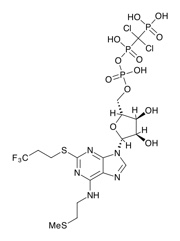
Cangrelor
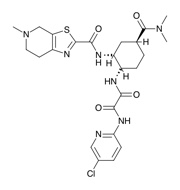
Edoxaban
A novel medicine to treat heart failure was also approved. Novartis’s Entresto combines the already-approved valsartan, an angiotensin II receptor blocker, with sacubitril, a drug that acts via a novel mechanism. This blocks the enzyme neprilysin, enhancing the heart’s protective neurohormonal systems. It is indicated for the treatment of adults with symptomatic chronic heart failure with reduced ejection fraction, a condition in which the heart fails to contract effectively and thus pumps less oxygen-rich blood out round the body. About half of all patients with heart failure fall into this category.
There are several new treatments for clotting disorders. Cangrelor (Kengrexal) from The Medicines Company is a direct P2Y12 platelet aggregation inhibitor designed to block ADP-induced platelet activation and aggregation. It was approved for administration via infusion to patients undergoing percutaneous coronary intervention, in combination with aspirin, for the reduction of thrombotic cardiovascular events.
Daiichi Sankyo’s edoxaban (Lixiana) is a selective direct and reversible inhibitor of Factor Xa, one of the factors on the coagulation cascade. By blocking its action, the generation of thrombin is reduced, thus extending clotting time and reducing the risk of thrombus formation. It is designed to prevent stroke and systemic embolism in adults with atrial fibrillation, and also to prevent deep vein thrombosis and pulmonary embolism.
A reversal agent for another anticoagulant was also approved. Idarucizumab (Praxbind) from Boehringer Ingelheim is a monoclonal antibody (mAb) designed to give complete reversal of the effects of the company’s anticoagulant dabigatran (Praxbind) within five minutes of administration. If patients being treated with the anticoagulant require emergency surgery, or have uncontrolled or life-threatening bleeding, being able to reverse the drug’s effects would be exceedingly useful.
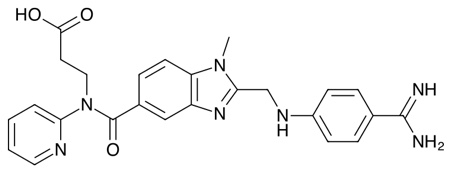
Dabigatran
Uncontrolled bleeding is a significant problem for people with haemophilia, and two new medicines for different forms of the condition were approved. Biogen Idec’s efmoroctocog alfa (Elocta) is a replacement therapy that temporarily increases the plasma levels of factor VIII, and thus renders the patient less prone to bleeding. It can be used prophylactically or in the case of bleeding events. Baxalta’s susoctocog alfa (Obizur), meanwhile, is designed to treat bleeding episodes in patients with acquired haemophilia caused by antibodies to factor VIII. It is a porcine recombinant factor VIII.
Also on the clotting front, two products designed to assist in haemostasis and wound healing were approved. Raplixa is a combination of human plasma-derived fibrinogen and thrombin in powder form from ProFibrix that promotes the coagulation of blood via the clotting cascade. It is indicated for use as a sealant when standard surgical techniques do not sufficiently improve haemostasis. And Episalvan from Birken is a birch bark extract that is thought to modulate various pro-inflammatory mediators in the first few days of wound healing. This reduces the healing time of wounds where the upper layer of the skin has been damaged, such as in burns or surgical skin grafts.
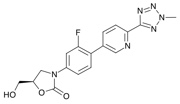
Tedizolid
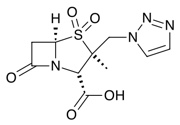
Tazobactam
The list also contains numerous anti-infectives, including three antibacterial products. Tedizolid phosphate (Sivextro) is a novel oxazolidinone antibiotic from Cubist (now Merck Sharp & Dohme), which inhibits protein biosynthesis in bacterial cells by binding to the 50S ribosomal subunit. It is active against various Gram positive bacteria, including methicillin-resistant S. aureus and pathogenic streptococci, and is indicated for the treatment of acute bacterial skin and skin structure infections.
Another product from Merck Sharp & Dohme (MSD), Zerbaxa, combines the novel fifth-generation cephalosporin ceftolozane, and tazobactam, a beta-lactamase inhibitor designed to protect the cephalosporin from hydrolysis. Ceftolozane binds to penicillin-binding proteins and results in the inhibition of bacterial cell wall synthesis, leading to cell death. It is licensed to treat complicated intra-abdominal infections, acute pyelonephritis and complicated urinary tract infections.
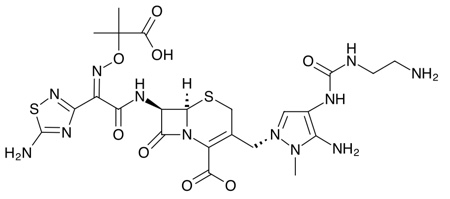
Ceftolozane
The third novel antibacterial, oritavancin (Orbactiv) from The Medicines Company, is a glycopeptide compound that inhibits bacterial cell wall biosynthesis and disrupts the membrane integrity of the bacteria, again leading to cell death. A single intravenous dose can cure acute bacterial skin and skin structure infections.
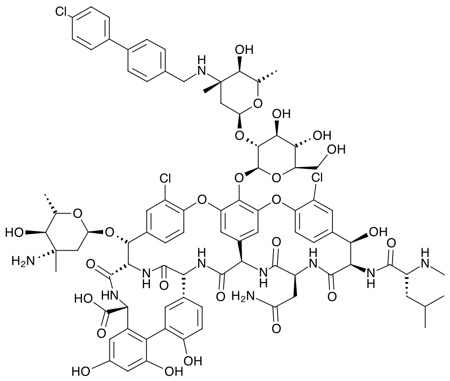
Oritavancin
These three are joined by a novel antifungal agent, Basilea’s isavuconazole (Cresemba). The triazole drug blocks the synthesis of ergosterol in the fungal cell membrane by inhibiting the enzyme lanosterol 14-alpha demethylase. It can be used to treat invasive aspergillosis and mucormycosis, both life-threatening diseases with limited treatment options.
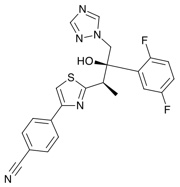
Isavuconazole
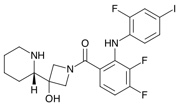
Cobimetinib
Finally on the infection front come three novel combination products for HIV infection. Bristol-Myers Squibb’s Evotaz combines the HIV-1 protease inhibitor atazanavir co-formulated with the pharmacokinetic enhancer cobicistat. Dutrebis from MSD combines the reverse transcriptase inhibitor lamivudine and the integrase inhibitor raltegravir. And Gilead’s Genvoya is a quadruple combination, containing integrase inhibitor elvitegravir, two reverse transcriptase inhibitors, emtricitabine and tenofovir alafenamide, and cobicistat.
Of course, many of the new drugs in 2015 are designed for use in various forms of cancer therapy. Four of these are for melanoma, two of which are antibodies that potentiate T-cell responses via the blockade of the programmed death 1, or PD-1, receptor binding to PD-L1 and PD-L2 ligands. The products, nivolumab (Opdivo) from Bristol-Myers Squibb (BMS) and MSD’s pembrolizumab (Keytruda), are indicated for unresectable or metastatic melanoma.
Roche’s cobimetinib (Cobellic) blocks the mitogen-activated protein kinase, or MAPK, pathway by targeting the kinases MEK1 and MEK2. This inhibits intracellular signalling and decreases tumour cell proliferation. It was approved to treat unresectable or metastatic melanoma in combination with the BRAF inhibitor vemurafenib; it also delays the onset of resistance compared with using vemurafenib as monotherapy.
The fourth new melanoma treatment is rather different. Amgen’s talimogene laherparepvec (Imlygic) is an oncolytic virus derived from Herpes simplex 1 that has been genetically engineered to replicate within tumours, and produce the immune stimulatory protein human GM-CSF. This promotes a systemic antitumour immune response, and an effector T-cell response; first it uses the cell’s energy stores to replicate, eventually causing cell death, and then copies of the virus are released into the bloodstream to infect further tumour cells. It cannot replicate in healthy cells, and thus they are left undamaged. It is the first oncolytic immunotherapy medicine that has been recommended for approval in Europe.
Sonidegib (Odomzo) from Novartis is targeted at another form of skin cancer, locally advanced basal cell carcinoma (BCC) that is not amenable to curative surgery or radiation therapy. It inhibits the Hedgehog pathway, a key regulator of development and morphogenesis in mammals, and which is also linked to the pathogenesis of several cancers, including BCC.
Four products targeting non-small cell lung cancer were also approved. One of these is BMS’s PD-1 inhibitor nivolumab, which was given the go-ahead in this indication, as well as melanoma. Another antibody, Eli Lilly’s necitumumab (Portrazza), is indicated for the treatment of epidermal growth factor receptor, or EGFR, expressing squamous NSCLC. It is a recombinant human IgG1 monoclonal antibody that binds to human EGFR, blocking the ligand binding site.

Osimertinib
AstraZeneca’s osimertinib (Tagrisso) was given a conditional licence, based on uncontrolled Phase II data. It is for treating locally advanced or metastatic NSCLC associated with the T790M genetic mutation. Like necitumumab, it acts at EGFR, in this case those with the sensitising mutations EGFRm and TKI-resistance mutation T790M. This mutation may develop in tumours on treatment, reducing the effect of anti-EGFR therapy. Full approval may be given after a comparative Phase III study has been completed.
Also given conditional approval after non-comparative Phase II was ceritinib (Zykadia) from Novartis, for patients with anaplastic lymphoma kinase, or ALK, positive NSCLC who have previously been treated with the ALK inhibitor crizotinib and have either progressed or did not respond. It inhibits the autophosphorylation of ALK, ALK-mediated phosphorylation of downstream signalling proteins, and the proliferation of ALK-dependent cancer cells. Again, full approval is conditional on successful comparative Phase III trial results.
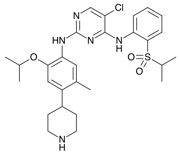
Ceritinib

Lenvatinib
Another kinase inhibitor, Eisai’s lenvatinib (Lenvima) is intended to treat patients with differentiated thyroid carcinoma. It is a selective inhibitor of vascular endothelial growth factor (VEGF) receptors, plus other pro-angiogenic and oncogenic pathway-related receptor tyrosine kinases, and can have an anticancer effect in thyroid cancer patients whose disease progresses despite treatment with radioactive iodine.
A rare cancer that affects children, high-risk neuroblastoma, can now be treated with dinutuximab (Unituxin) from United Therapeutics Europe if they have responded to an induction treatment with chemotherapy, followed by myeloablative therapy and autologous stem cell transplantation. This cancer forms from immature nerve cells, typically in under-5s, and usually presents as a lump in the abdomen or round the spine. The monoclonal chimeric antibody reacts specifically with the gangioside GF2, which is highly expressed on the surface of neuroblastoma cells, but only minimally expressed on the surface of normal human neurons, peripheral pain fibres and skin melanocytes. It is to be given in combination with GM-CSF, interleukin-2 and isotretinoin.
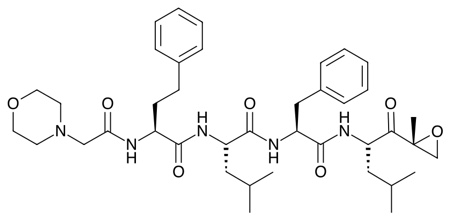
Carfilzomib
There are also multiple new drugs to treat blood cancers, including two for multiple myeloma. Amgen’s carfilzomib (Kyprolis) is an irreversible proteasome inhibitor, indicated for second line therapy in combination with lenalidomide and dexamethasone. By blocking the proteasome, proteins accumulate within the cancerous plasma cells, ultimately causing cell death.

Panobinostat
Panobinostat (Farydak) from Novartis treats multiple myeloma via a different mechanism: it inhibits histonedeacetylases, or HDACs, which play a role in gene activation within cells. This inhibition leads to increased acetylation of histone proteins, which results in transcriptional activation. It has been approved as third-line therapy in combination with bortezomib and dexamethasone, where the previous regimens tried included bortezomib and an immunomodulatory agent.
Three new products are targeted at acute lymphoblastic leukaemia (ALL). Amgen’s blinatumomab (Blincyto) is a mAb designed to treat the Philadelphia chromosome-negative form of the disease. And two related enzyme products were approved. Medac’s asparaginase (Spectrila) degrades the amino acid asparagine, the depletion of which in blood serum leads to apoptosis of cells that are highly dependent on asparagine, notably leukaemic blasts. Pegaspargase (Oncaspar) from Baxalta is used in patients who are hypersensitive to native forms of asparaginase. Both are indicated as components of antineoplastic combination therapy.
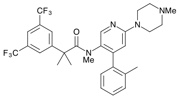
Netupitant
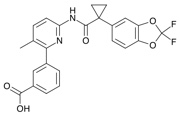
Lumacaftor
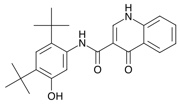
Ivacaftor
Chemotherapy-induced nausea and vomiting is a common problem with cancer treatment, and a new product for its prevention is Helsinn’s Akynzeo, a combination of netupitant and palonosetron. Netupitant is a selective antagonist of human substance P/neurokinin 1 receptors, and palonosetron an already-marketed 5-HT3 antagonist. It is licensed for the prevention of acute and delayed nausea and vomiting associated with highly emetogenic cisplatin-based cancer chemotherapy, and also in moderately emetogenic therapy regimens.
Away from cancer, an antibody, mepolizumab (Nucala) from GlaxoSmithKline has been approved as an add-on treatment of severe refractory eosinophilic asthma. The humanised mAb targets targets interleukin-5, which is involved in the growth and survival of the eosinophils involved in this form of asthma.
A new treatment for cystic fibrosis, Vertex’s Orkambi, is a combination of lumacaftor and ivacaftor. It is indicated for the subset of CF patients with the specific F508del mutation affecting the CF transmembrane conductance regulator, or CFTR, gene that encodes for the CFTR protein. This is a chloride channel normally present at the surface of epithelial cells in numerous organs. Lumacaftor improves the cellular processing and trafficking of the protein to the cell membrane, and ivacaftor increases CFTR channel gating. The result is increased chloride ion transport.
Numerous products with enzymatic activity were also approved. Sebelipase alfa (Kanuma) from Synageva BioPharma treats lysosomal acid lipase deficiency, and is a recombinant human lysosomal acid lipase. It results in reduced liver fat content and reduced levels of blood transaminases, LDL and HDL cholesterol, and triglycerides.

Tolvaptan
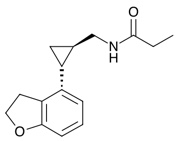
Tasimelteon
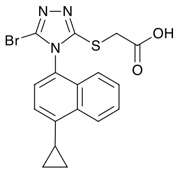
Lesinurad

Pitolisant

Guanfacine
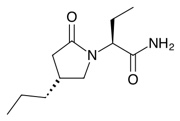
Brivaracetam
CSL Behring’s Respreeza is a human alpha-1 proteinase inhibitor, designed to treat those with a deficiency of this enzyme. It is an alpha-1 antitrypsin derived from collected human blood, and restores the level of alpha-1 antitrypsin in the lungs in deficient patients. It can slow down the annual rate of lung density decline.
Asfotase alfa (Strensiq) from Alexion treats paediatric-onset hypophosphatasia. The human recombinant tissue-nonspecific fusion protein improves skeletal structure and can give apparent catch-up height gain in patients with this condition.
Otsuka’s tolvaptan (Jinarc) slows the progression of cyst development and renal insufficiency of autosomal dominant polycystic kidney disease. It is a vasopressin antagonist that decreases cyst proliferation by reducing intracellular cAMP levels, and can slow down the worsening of kidney function. AstraZeneca’s lesinurad (Zurampic) is a selective uric acid reabsorption inhibitor that inhibits uric acid transporter 1. It is to be used in combination with a xanthine oxidase inhibitor for the treatment of gout.
In the CNS field, Tasimelteon (Hetlioz) from Vanda Pharmaceuticals is a melatonin receptor agonist to treat non-24-hour sleep–wake disorder in totally blind adults. It acts as a circadian regulator that resets the master body clock in the suprachiasmatic nucleus, something that is normally done naturally in response to light. Also in the sleep field, Bioprojet’s pitolisant (Wakix) is an antagonist/inverse agonist of the histamine H3 receptor for the treatment of narcolepsy, which works by enhancing histaminergic transmissions in the brain.
Shire has added guanfacine (Intuniv) to its ADHD portfolio. The selective alpha-2A adrenergic receptor agonist modulates the brain signalling pathways believed to lead to ADHD symptoms. And brivaracetam (Briviact) from UCB Pharma is an antiepileptic that interferes with synaptic vesicle protein 2A, and treats partial-onset seizures.
